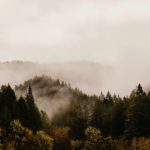The Deep End, directed by Jon Kasbe, is a documentary about the spiritual teacher Teal Swan, who has been a controversial figure for years. While she has consistently attracted a large number of “haters,” this is the first mainstream coverage/expose of her work. It raises at least as many questions about the intentions and integrity of the media and documentarians as it does about Teal Swan and her organization.
I don’t have strong feelings about Teal Swan one way or the other. I subscribe to her YouTube channel and have watched probably 10 or so hours of her content over the last few years. Some of it is insightful, but I don’t have any urge to attend a live workshop. I watch many people but don’t really “follow” anyone. The word “follow” is relevant here because, in The Deep End, they insisted on labeling almost anyone who attends an event a Teal Swan “follower,” which is a loaded word typically applied to cult members. Just to be clear, this is mainly a discussion and review of the documentary The Deep End, and not of Teal Swan and her work. I’m not nearly familiar enough with the latter to have an informed opinion.
Documentarians as Narcs
If you are going to watch The Deep End, I highly recommend going to Teal Swan’s YouTube channel and watching her responses. She claims that the producers, who filmed her for 3 years, misrepresented the intentions of the project, at first assuring her that it would be portrayed in a positive light. While this may seem like a case of “they said, she said,” I doubt that she would have given permission to do such intensive filming if she knew that she would be portrayed as a cult leader. It seems like the director Kasbe and his crew approached the project with the mentality of narcs or undercover agents, infiltrating the organization and pretending to be allies.
Teal Swan points to the many ways that the documentary distorts reality, including the spooky music that often plays ominously in the background. Most notably, when you have hundreds of hours of footage and edit it down to a few hours, it’s easy to paint just about any picture you want. Cults are very popular right now and they make for sensationalistic TV.
This isn’t to say that Teal Swan is beyond reproach. When someone reaches her level of influence, it’s inevitable that “followers” will have good and bad experiences. One area that her critics (including the makers of The Deep End) have always focused on was her attitude towards suicide. While Swan doesn’t advocate suicide, she does talk openly about it, recognizing that it’s an option. Unfortunately, a certain number of people (a growing number) do take their own lives. This includes people who watch Teal Swan, as well as people who are under the care of psychiatrists and psychologists. However, the point of a program such as The Deep End is to point an accusing finger at Teal Swan.
Just about any popular self-help or spiritual teacher could be labeled a cult leader. Right now, this would include Anthony Robbins, Sadhguru, GaryVee, Abraham Hicks, and many others. if you applied a microscopic view to any organization and applied selective editing, you could alternately make anyone seem like a true savior or a complete charlatan.
By the last couple of episodes, The Deep End devolves into pure melodrama and cheesy horror movie effects, casting Swan as a demonic figure. Clearly, the intention here is to push a certain narrative and the intended audience are viewers who accept such narratives at face value.
The Media: Exposing Cults or a Cult In Itself?
The Deep End is a fascinating example of how media and art forms such as documentaries can construct reality. Personally, I am more interested in this general concept than I am in the doc itself or even Teal Swan and her teachings.
For anyone who shares this kind of bizarre obsession with the cultoid, propaganda, and how the media creates and distorts perceptions, I’d recommend watching The Deep End along with Teal Swan’s reactions (there are 4 videos, one in response to each episode).
It’s usually too flip and simplistic to say that the truth probably lies somewhere in the middle, but in this case, it truly seems like the most likely scenario.

